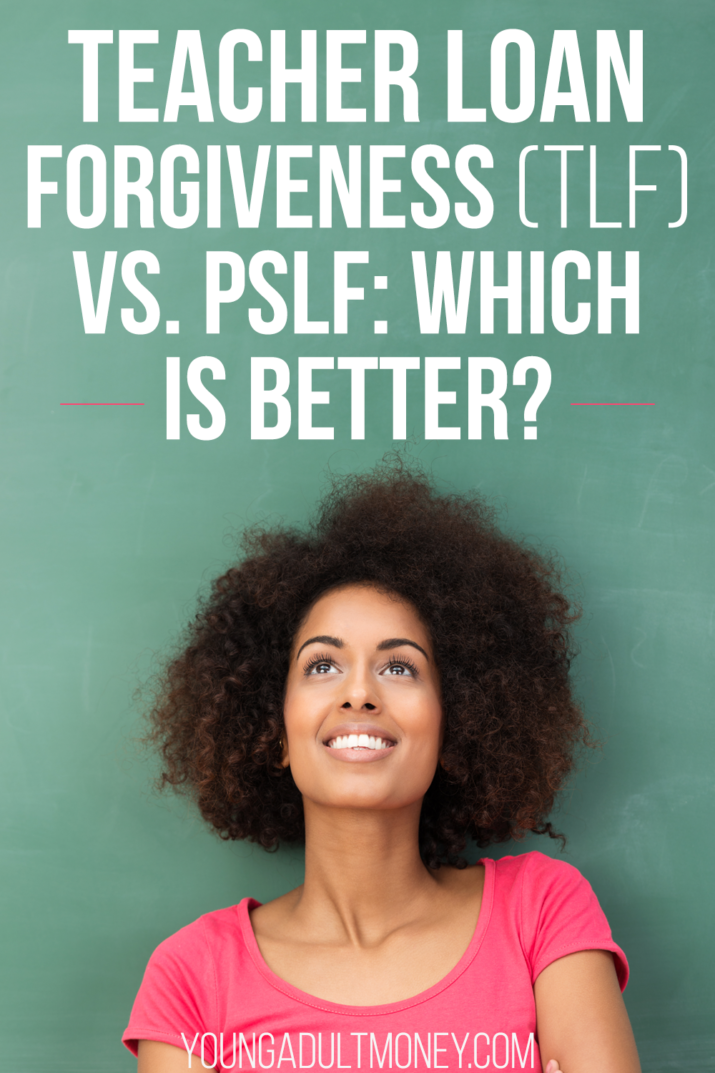 I went to a private four-year university for undergrad. Some of the people I met throughout my time there were education majors.
I went to a private four-year university for undergrad. Some of the people I met throughout my time there were education majors.
It’s very common to leave my alma mater with tens of thousands in student loans. It’s also common for teachers to make very little at the beginning of their careers. Not surprisingly there are teachers who have student loan debt that is double their income, or more.
Thankfully there are options for teachers who are struggling with their student loan debt, including opportunities for partial or total loan forgiveness.
There are two major paths to student loan forgiveness for teachers. They include Teacher Loan Forgiveness (TLF) and Public Service Loan Forgiveness (PSLF). Because there are a number of teachers who start out in the profession and move to a different field, we’ll also touch on income-driven loan forgiveness.
Let’s start by going over the requirements of each program and see which option is best for teachers.
Teacher Loan Forgiveness
Teacher Loan Forgiveness, or TLF, forgives up to $5,000 or $17,500 after teaching full-time for five consecutive academic years of qualifying employment and repayment.
You must teach at an elementary school, secondary school, or educational service agency that serves low-income students. Each year the Department of Education publishes a directory of which schools are designated as low-income. You need to teach five consecutive years, full-time, but there are some exceptions where the academic year could count even if you didn’t teach for an entire school year.
You also must be a “highly qualified teacher” for each of the five academic years you were employed at an eligible low-income school. A highly qualified teacher is someone who:
- Received a bachelor degree
- Fully certified in the State where they teach
- Has not had any licensing or certification requirements waived for any reason
If you are a teacher who is new to the profession there is additional requirements, which you can read here. My high-level takeaway is that you need to pass a “rigorous” test that demonstrates your knowledge of academic subjects that you teach, or have an undergrad or graduate degree in the subject(s) that you teach.
So who receives $17,500 and who receives $5,000? To receive up to $17,500 of loan forgiveness you need to be a special education teacher (elementary or secondary) or a secondary mathematics or science teacher. Everyone else is eligible for up to $5,000.
Eligible loans include both Federal Direct loans and Federal Family Education Loans (FFEL). Direct PLUS and Federal Plus loans are not eligible, neither is any portion of a consolidation loan that repaid a PLUS loan.
The application process for forgiveness is to fill out the Teacher Loan Forgiveness application and submit to your loan servicer.
Forgiven debt is not taxable.
You can read all the details of Teacher Loan Forgiveness at the Federal Student Aid website.
Not surprisingly, Teacher Loan Forgiveness is typically the type of loan forgiveness that teachers first think of or hear about. After all, it is specific to the teaching profession. With how much student loan debt graduates are leaving college with, though, I always encourage teachers to get grounded in Public Service Loan Forgiveness as well. Let’s go over that next.

Public Service Loan Forgiveness
Public Service Loan Forgiveness, or PSLF, has received a lot of press lately. Contrary to negative media reports, PSLF is nothing to be afraid of and the acceptance rate will only continue to rise over time (it already has). It can be extremely beneficial if you have a high level of student loan debt relative to your income.
Before we get too far ahead of ourselves, let’s go over the basics of PSLF.
There are a few core requirements for PSLF:
- Make 120 qualifying monthly payments…
- on a qualifying loan or loans…
- while working full-time for a qualifying employer
If you fulfill all the requirements and your application gets accepted, your loan balances will be forgiven tax-free. Unlike Teacher Loan Forgiveness, PSLF has no cap. You could get $10,000 forgiven. Or $100,000. Or a million dollars.
The payments also do not have to be consecutive. You could make 36 qualifying payments, take a few years off, and then start making qualifying payments again. This is more flexible than Teacher Loan Forgiveness which requires five consecutive years of work.
Qualifying repayment plans include the standard ten-year repayment plan and the four income-driven repayment plans. You can read more about the four income-driven repayment plans here. Graduated, extended, or any other repayment plan is not eligible for PSLF.
As far as loans go, here are the types of student loans that qualify for PSLF:
- Direct Subsidized
- Direct Unsubsidized
- Direct Graduate PLUS
- Direct Parent PLUS (only if consolidated through a Direct Consolidation Loan)
- Direct Consolidation
Any Direct loan other than Parent PLUS is eligible, though Parent PLUS loans can also become eligible when they are consolidated through a Direct Consolidation Loan. Note that ICR is the only income-driven repayment plan that Parent PLUS is eligible for, which is also the least advantageous. Make sure you fully understand the implications before going through with student loan consolidation).
Notably this leaves out FFEL loans, which many people still have. Like Parent PLUS loans, FFEL loans can become eligible for PSLF if they are consolidated into a Direct Consolidation loan. Again I stress the importance of understanding the implications of consolidation before going through it. I go into detail on this topic in Student Loan Solution.
Finally let’s move on to qualifying employers. For a payment to be tagged as qualified, you must make the payment while working full-time for a qualified employers.
- Government organizations at any level (federal, state, local, or tribal)
- Not-for-profit organizations that are tax-exempt under Section 501(c)(3) of the Internal Revenue Code
- Other types of not-for-profit organizations that are not tax-exempt under Section 501(c)(3) of the Internal Revenue Code, if their primary purpose is to provide certain types of qualifying public services
I cover PSLF and many other student loan and personal finance topics in my book Student Loan Solution: 5 Steps to Take Control of Your Student Loans and Financial Life.
Which is Better? TLF or PSLF?
So you have Teacher Loan Forgiveness and Public Service Loan Forgiveness. Which is better?
- TLF forgives up to $17,500 for certain types of teachers, or $5,000 for everyone else. PSLF has no cap on the amount of debt you can have forgiven.
- Forgiven amount is not taxed under either TLF or PSLF.
- TLF is available after five years compared to ten years for PSLF.
- TLF must be completed in five consecutive years, while PSLF qualified payments do not have to be consecutive.
- TLF is limited to teachers, while PSLF is available to teachers and those working in other professions
At a high level it’s difficult to compete with PSLF. $5,000, which is the amount a majority of teachers will be eligible for under TLF, doesn’t go that far if you have $30,000 or $100,000 in student loan debt.
One other important, and unfortunate, aspect of TLF is that you can’t double-up the five years with PSLF. Meaning, if you have completed the five year requirement for TLF, apply, and are granted forgiveness, you can’t use any of those years towards PSLF.
With that in mind I highly recommend teachers look into whether they would benefit from PSLF. Especially if you use strategies to maximize PSLF, it could be much more beneficial than TLF.
I also don’t like that TLF potentially locks you into a job you hate. What if after two years you realize you want to move to a different school district, one that doesn’t qualify for TLF? Or you want to leave education entirely? Or take a year off? All of these things could derail TLF.
PSLF, on the other hand, doesn’t discriminate between payments made while working as an educator and those made while working in a totally unrelated field as long as the employer is a qualified employer.
For a majority of teachers, Public Service Loan Forgiveness will be a more beneficial path than Teacher Loan Forgiveness.
I hope you found this guide to student loan forgiveness for teachers useful. Student loans are complicated, but the more time you spend understanding your options the better you will feel about your repayment strategy. This will spill over to the rest of your financial life, at least it has for many I have talked to and worked with.
A few additional resources you may find helpful:
- Student Loan Spreadsheet – This isn’t an ordinary spreadsheet. While it does center around inputting all your student loan information in one spot, there is a lot of extras in here including calculators (including income-driven repayment) that will help you understand your options better.
- Student Loan Solution: 5 Steps to Take Control of Your Student Loans and Financial Life – I am so proud of this book and I think you’ll agree with thousands of others who have found it useful. I interviewed over ten experts and hit on a wide range of important topics like student loans and mental health and the importance of having an F off Fund.
- Private Student Loans Guide: How to Save Thousands (2020) – We talked a lot about federal loans in this post. Unfortunately private student loans are not eligible for student loan forgiveness, but there are still strategies to repay them in a way that keeps as much money as possible in your pocket.

